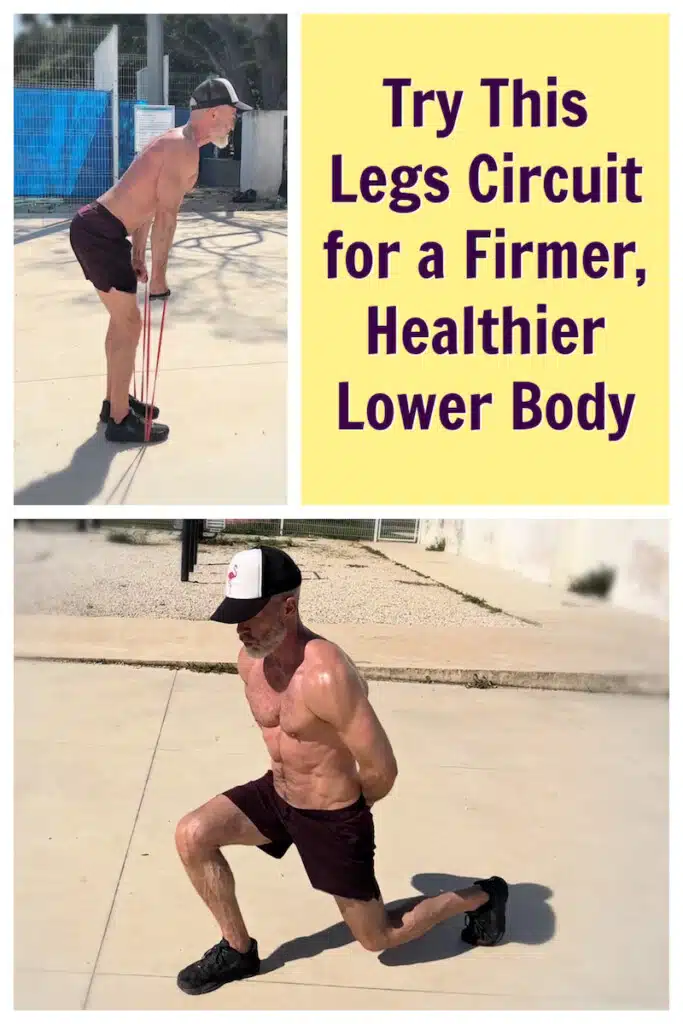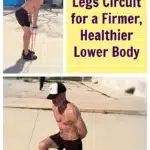This is one of my top three favorite workouts of all time. It’s a lower-body blitz that will create healthier, steel-like leg muscles.
The workout is done in a circuit-training format. I enjoy circuit training because it keeps things exciting and fun, plus my heart rate stays elevated, so I sweat more and burn calories efficiently.
Anything I can do to help my body utilize the energy stored within my fat cells is a very good thing as far as I’m concerned.
I’ve included a video below that should prove helpful to you.
Lower-Body Blitz! Try This Workout for Better-Looking Legs
This workout has been specifically designed to sculpt your thigh muscles symmetrically – in a way that adds tone, definition, and strength.
Basically, it makes your legs a lot firmer.
This is one my favorite workouts for legs; I usually do this one outdoors if weather permits.
To offset the fact that you’re not lifting heavily plated barbells or using machines, the volume is increased (the number of exercises), and extra attention is paid to excellent technique (which means: good form, full range of motion, and a peak contraction within each rep).
How to Combine Nutrition with Exercise for Super Healthy Legs
Before I begin, let me offer you a friendly reminder that if you want to get exponential results from workouts (positive and visibly evident improvements to your physique), you can combine consistent workouts with an anti-inflammatory diet.
Eating a cleaner, healthier diet designed to reduce inflammation in your body – and where the carbohydrates in your daily menu come almost entirely from vegetables – becomes like rocket fuel to your workouts, making them even more effective. This is my personal opinion. Ask your doctor before significantly changing your eating or movement patterns.
What You Need for This Thigh Circuit Workout
For this workout, if you have a resistance band, that can be helpful.
Or, if you have kettlebells or dumbbells, those can be used in place of the resistance band.

Circuit training is a type of training where a series of exercises are performed one after the other. It involves performing high repetitions of exercises with little rest in between, which can lead to an increase in the muscle’s ability to sustain work over time.
Basically, it results in improved overall lower body strength and function – and great-lookin’ thigh muscles. A recent research study from 2021 establishes that there are significant benefits from functional circuit training for enhancing various components of physical fitness – including strength, power, balance, and agility – and suggests that functional training can contribute to overall leg strength and health.
How many times you go through each circuit is determined by your current fitness level:
• Beginners = 2x each circuit
• Intermediates = 3x each circuit
• Advanced Athletes = 4x each circuit.
How many repetitions you do is up to you. 12 is usually a good number to shoot for.
If you’re a beginner, do fewer reps. If you’re advanced, do more.
The Strategy Behind This Legs Circuit-Training Workout
Working all the major muscle groups of your lower body in a balanced way is important for overall thigh strength, stability, and function. The major muscle groups of your lower body targeted within this workout are:
Quadriceps: These muscles are located in the front of the thigh and include the rectus femoris, vastus lateralis, vastus medialis, and vastus intermedius. They are responsible for extending the knee.
Hamstrings: These muscles are located in the back of the thigh and include the biceps femoris, semitendinosus, and semimembranosus. They are responsible for flexing the knee and extending the hip.
Glutes: These muscles are located in the buttocks and include the gluteus maximus, gluteus medius, and gluteus minimus. They are responsible for extending and externally rotating the hip.
Calves: These muscles are located in the back of the lower leg and include the gastrocnemius and soleus. They are responsible for plantarflexion of the ankle joint.
Hip Flexors: These muscles are located in the front of the hip and include the iliacus and psoas major. They are responsible for flexing the hip joint.
Adductors: These muscles are located on the inner thigh and include the adductor brevis, adductor longus, and adductor magnus. They are responsible for adduction of the hip joint.
Abductors: Your outer thigh muscles.
I encourage you to begin this workout slowly at first. You can gradually add speed and intensity after as you feel your body’s muscles and joints limbering up.
THIGH MUSCLES WARM-UP – CIRCUIT A
– Alternating Forward Lunge (on a platform)
– Standing Bicycle Twist
– Standing Heel Raise
– Alternating Step-Up
– Sit Squat.
CIRCUIT B FOR LEGS
– Box Jump
– Banded Straighter-Leg Deadlift
– Banded Front Squat
– Hanging Knee Raise.
THIGH MUSCLES BLITZ – CIRCUIT C
– Stationary Side-to-Side Lunge
– 3-Part 90-Second Plank (elbow plank/push-up plank/alternating leg lift)
– Reverse Lunge
– Single-Leg Heel Raise
– Banded Crab Walk.
CIRCUIT D FOR LEGS
– Jumping Jack (40)
– Banded Arm Press (for oblique stabilization)
– Banded Woodchopper
– Single-Leg Elevated Side Lunge
THIGH MUSCLES BLITZ – CIRCUIT E
– Air Squat with Elevated Heels
– 3-Part Single-Leg Glute Bridge (hip thrust/pulse/inner-thigh opener)
– Single-Leg Step Up (on a higher platform)
– Sit-Up (or crunch).
COOL-DOWN STRETCH
– Elevated Pigeon.
Tips for Healthier Thigh Muscles
- For sit squats, there is a one-second pause at the bottom of each squat during which you “sit,” and yet core and glute muscles remain activated.
- For the banded deadlift, your leg can remain primarily straight. Try to initiate this movement from your hamstrings.
- For the stationary side-to-side lunge, keep the entire soles of your feet pushing down into the ground at all times.
- Use your phone’s timer for the 90-second plank (30 seconds for each part).
- For heel raises, exaggerate the range of motion and contract the muscle fibers intensely within your calf at the top of each repetition.
Finally, I encourage you to avoid some of the more common mistakes people make when training their thigh muscles:
Neglecting proper warm-up: Skipping a proper warm-up can increase the risk of injury and decrease performance during the workout. It’s important to warm up with dynamic stretching, light cardio, or mobility exercises to prepare the muscles for exercise.
Overemphasizing certain muscles: Many people focus too much on training the quadriceps and neglect other important lower body muscles like the hamstrings, glutes, and calves. This can lead to muscle imbalances and increase the risk of injury.
Poor exercise form: Poor exercise form can lead to injury and decreased effectiveness of the exercise. Examples of poor form include using too much weight, improper posture, and improper alignment.
Ignoring unilateral training: Unilateral training, which involves training one leg at a time, is important for addressing muscle imbalances and improving overall lower body strength and stability. Lunge variations are a good remedy to this problem!
Not enough variety in workouts: Doing the same exercises and routines over and over can lead to plateaus in progress and decreased motivation. It’s important to vary exercises and workouts to challenge the muscles and prevent boredom.
Neglecting recovery: Proper recovery is important for preventing injury and allowing the muscles to repair and grow stronger. Not getting enough rest, sleep, or proper nutrition can hinder progress and increase the risk of injury.
Overall, circuit training can be a wise idea when targeting the thigh muscles because it provides a time-efficient, versatile, and effective way to improve muscular strength, endurance, and cardiovascular fitness while firming, shaping, and defining the legs.
